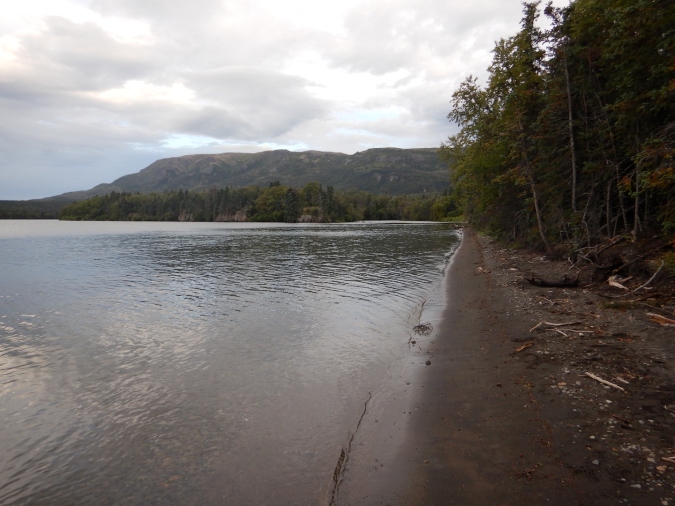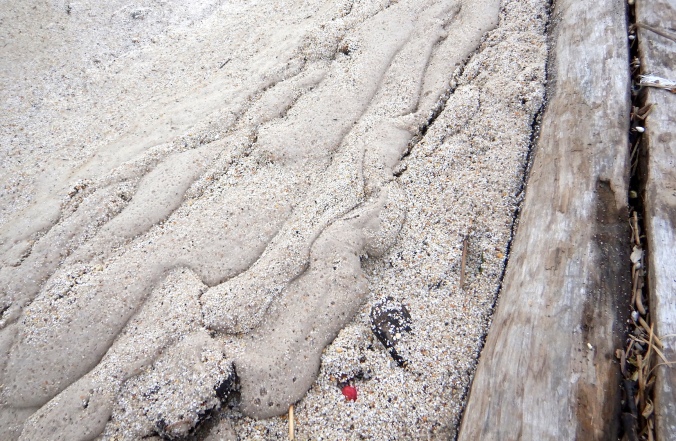Due to strong winds, I was unable to reach Brooks Camp on time. The next morning, as instructed by Katmai Air, I arrived at their dock before 7 a.m. I was eager to get on the “first load.” Evidently everyone who didn’t reach Brooks Camp the previous day was told they’d be on the “first load,” which caused Katmai Air to deal with some cranky customers. (Not me, I might add, but I understood others’ frustration.)

Looking southwest toward Mount Brooks from the air.
Around 8:40 a.m., I arrived at Brooks Camp—or Lake Brooks to be exact. Winds out of the east were still too strong for planes to land on Naknek Lake, but I didn’t mind the view of Dumpling Mountain and the head of Brooks River.

Dumpling Mountain and the outlet of Lake Brooks
After heading straight to the visitor center to get my bear orientation…

Yes, even former rangers are required to attend the bear safety talk upon arrival at Brooks Camp.
…I hurriedly pitched my tent in the campground….

My tent in the far southwest corner of the campground, as far away from other people as I could get.
…and walked back to the lower river to binge watch bears.

Fine pumice sand, evidence of the powerful winds from the previous day’s storm, was all over the beach.
In September, the wildlife-viewing platform near the mouth of Brooks River is my favorite place to be. Upstream, just where the river enters my line of sight from the platform, thousands of salmon work to complete their life cycle. As the fish weaken and die, the river’s current sweeps them downstream. Where the river’s current is not longer strong enough to carry them further, it drops the barely live and dead fish, making the river mouth and meanders just upstream the most productive salmon scavenging areas at Brooks.
When I arrive on the platform four subadult bears play and fish, while 409 Beadnose and cubs lounge nearby. After another large salmon run, the bears at Brooks River are well fed, and perhaps as a result the younger bears were especially playful.

One light brown subadult bear out of this bunch very much resembles 273’s yearling in 2016. This bear appears to be a young subadult, but is large for a 2.5 year-old.
Around noon, after Beadnose and cubs settled into a nap below the platform, I decided to visit Brooks Falls, where bears had been fishing in higher than average numbers for this time of year. I had a hypothesis as to why, but I needed at least a few cursory observations to support it.
Over my short stay, the vast majority of fish I saw bears catch at the falls were silver (coho) salmon. This run begins in August and often continues through September. Larger on average than sockeye, a single, fresh silver salmon can provide several thousand calories for bears skilled enough to catch them. Like the beginning of the sockeye run in late June and July, the late run of silver salmon is most accessible to bears at Brooks Falls.

Two adult male bears, 68 (left) and 879, fish the far pool of Brooks Falls.
But bears in the lower river make huge energy profits as well. In the early evening, after skipping a true lunch to eat an early dinner (to maximize bear watching time), I return to the lower river until sunset. 410 and 409 Beadnose both patrol the river slowly, snorkeling for any salmon that can swim away. In a half hour, 410 eats four fish. Over an hour, Beadnose leisurely consumes eight. These are relatively low catch rates for this section of river, yet even assuming the salmon carcasses provide less than half the energy they did in July (spawned out fish may contain 2000-2500 calories or less compared to the 4500 calories when the first arrived) 410 and 409 still ate at least 8,000 and 16,000 calories respectively. In past years, when 410 has remained within my line of sight longer at the lower river, I’ve counted her eating 41 fish in 3 hours 25 minutes. Even if she only ate part of each fish, when your profit is measured in calories needed to survive winter hibernation, this isn’t a bad day’s work.
As the sun begins to set behind the western toe of Dumpling Mountain, I relaxed to watch bears come and go from the river—128 Grazer, 409 Beadnose, 284, 410, 708, 610, four unidentified subadults, 879, 474, and many cubs. If the sun didn’t set so soon and I didn’t risk running a gauntlet of bears in the dark to get to the campground, I would’ve remained out for much longer. Responsible bear watching, however, includes not wandering around in the dark, so I retire to the campground eager for sunrise and another day on the river.

Love the video of the subadults playing. I hope your 2 nights at Brooks were everything you were hoping to get out of the experience. It’s funny to me that they still made you go through bear orientation. Has anything changed in the orientation since when you were last working there? I imagine you could give the whole orientation in your sleep!
LikeLike
Just wonderful, Mike. Bet it was hard to leave, but I’m glad you got to go back.
LikeLike
That is the subadult we all think is Velcro as well….
LikeLike
Hi Mike:
We all think that is 273’s cub too with his dark socks on too. If I recall right he (Velcro) was the largest of the 2016 yearlings and 94’s was the second biggest. Some of us think he is playing with 94’s cub and 504’s cubs (aka the ying yang twins or salt and pepper) possibly in your footage (other cam viewers got similar footage of them playing on the spit). But per Ranger Leslie via Ranger Dave the offspring of 273 is getting a number this year as are lots of subadults.
Hope you had a great albeit short trip to Brooks.
LikeLike
Mike, you can’t imagine how much I look forward to your blog. I’m happy you were able to get to Brooks, again, this year. Bill and I really want to visit again. We are planning another RV drive thru Canada to Whitehorse in mid May, again this year. We’ll turn in the RV at Whitehorse and then be taking the ferry from either Haines or Skagway down to Bellingham/Vancouver/ or nearby. Have you done this or do you have thoughts about it? We’d get a berth for sure and would like to spend an open ended amount of time getting off the ferry visiting different places. Info, suggestions, pros, cons? Thanks in advance. Keep writing. I saw the pic of the biting fly. Are they similar to the ones in AK?
Leanne Hopkins Clemson tiger from Greenville, SC
LikeLike
I took the Alaska Ferry from Bellingham to Haines in March 2013. It was a wonderful trip. I spent most of the daytime hours sitting in the forward lounge looking for whales and birds, and was lucky enough to see humpbacks, porpoises, and orcas. If the sun hadn’t set, I would’ve wanted to stay up all night.
My ferry schedule didn’t allow for much time to explore towns along the way as I had to get back to King Salmon. Since it was March though places like Ketchikan were nearly vacant. I did enjoy walking a short trail through the coastal forest near the ferry landing at Sitka. I have photos from the trip on Flickr if you’d like to browse them.
As for the biting flies of North Cascades, they are not the black flies you may have encountered at Katmai. They appear more closely related to what some people know as stable flies, but I’m still trying to find their genus and species. Someone undoubtedly knows since they are so abundant and appear every summer.
LikeLike
Now THAT’S what I love to read about. Sorry your time there was shortened, but thrilled you were there. Selfishly, I was hoping you’d do a live chat, but to be honest, That would have been a bit much to ask of you. Thanks for the blog!
LikeLike
thankyou Mike!!! I feel so close to the spirit of Katmai and the bears everytime you write!!!
LikeLike
Another excellent blog entry Mike.
LikeLike
Mike, Your blogs are golden and as always I enjoy reading about your adventures. So glad you finally made it to Brooks. Thank you for explaining where the abundance of the dead salmon end up at the rivers mouth and I am sure the bears know this too. Just curious when you camp at Brooks I see in the picture you posted there is a barbed wire fence, is that hot wired? Thanks
LikeLike
That is an electric fence, but not a barbed wire fence. Generally, any electric fence designed for livestock can be used to deter bears. With the electric fence around the campground, it’s rare for bears to get inside.
LikeLike
Thanks, good to know.
LikeLike
Well, no camping for me. If, instead of “rare”, you’d said “impossible”, I would have considered it. 🙂
Thanks for the details of your visit. Always a pleasure to hear your enthusiasm for Brooks.
LikeLike
Pingback: My Trip to Brooks Camp 2017: Day Three | Wandering at Large
Ranger Mike, thank you for the blog about your three day excursion back to Brooks Camp. Very interesting and I also had to laugh about you having to sit through the Bear Safety Briefing. BTW, do you know if the construction on the new bridge starts this winter or has that been delayed until next year?
LikeLike
Well I am glad you made it early in the day. I am amused about your attending bear school!
That was great footage of 610. She actually looks bigger there than on the cams, although she is still not bigger than subs a year younger than her. But she is doing so well and it is great seeing her interacting with other young bears. She needed the socialization to learn the skills she will need to be a bear.
Thanks for the calorie analysis on the spawned out salmon. I know live salmon have more calories, but the dying ones have less cost to catching them, both in terms of energy expended and risk of injury.
So happy that you saw that many bears in one day!
LikeLike
Hi Mike,
Your trip looks like it was awesome and THANKS so much for sharing with us. So nice to know you love Brooks and the Bears as much as we do and take the time to stay in touch. Smiles to you….Kacko
LikeLike
Hi Mike, I chuckled at “as far away from other people as I could get”, life’s simpler when there’s no bother. I wonder if the subadults in your video were 719 and a male I have been calling “mini” (for mini-503 due to their physical similarities) that were hanging out with 273’s cub in the opening scene – the video was a joy to watch! Do young bears seek safety in a tree like they do as cubs?
LikeLike
Pingback: Bear Necessities Intensifies: Lessons from a Semi-Viral Video | Wandering at Large